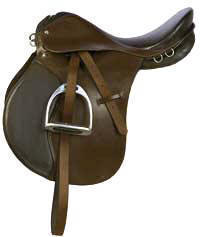 
Much has
influenced the development of the English saddles. From the
classical riding styles of the Spanish Riding School to the
English and Irish sport of jumping and steeple chases to the
European military styles of riding to the show ring, these
saddles have evolved from a history of privilege and also the
battlefield. Their design was and is based on balance of the
rider and comfort of the animal. Whether on the polo field, in
the heat of battle or in the show ring, these saddles needed to
fit correctly as to not interfere with the performance of the
horse or to sore him so he could not work again the next day.
In addition, simply because we
have chosen to refer to these types of saddles as English does
not mean they were used or developed exclusively by the
English. In fact, Italians, Germans, Poles, French and Russians
have used this type of saddle for centuries in pursuit of
jumping, racing, dressage, polo and showing. The forward seat,
which is what most saddles you find today will be considered,
was developed by an Italian in the late 1800's. Amid much
controversy over the years, this forward seat eventually
replaced the older classical style saddles.
These saddles seem small and
slight in comparison to the heavier western saddles of the New
World vaquero and cowboys. Yet, they are designed and built to
withstand great stress during sport, war and the rigors of
classical training. They should be made of the highest quality
in materials including leather, metal and wood.
Riding this style of tack affords
the rider close contact with the mule and a chance really to
concentrate on the aids. English riding teaches the rider
balance and finesse. Many equestrians feel this riding style
enhances skills and puts the rider in better contact with his
mount. The ultimate picture of elegance in equestrian circles
seems to be that of an English rider.
Mules are now showing themselves
to be competitive in English events traditionally dominated by
horses. You might be considering having your mule go English to
enhance its versatility. The most important piece of tack that
you will be considering, of course, will be the English saddle.
Here are some basic guidelines to help when you go into the tack
store.
Just like western saddles come in
specific designs for specific purposes, so do English saddles.
You=ll
want to know what you intend to do with your mule and what your
mule is suited for. If you are competing, you will also want to
check the rules under which you are showing for their
requirements in their English classes.
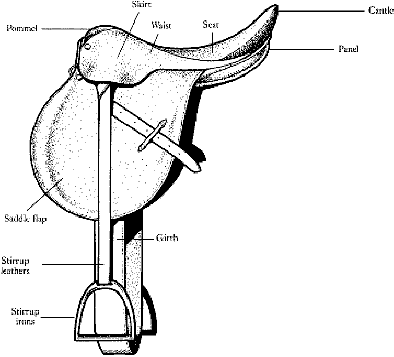
The other major characteristic
which defines an English saddle is that it has
panels: these are a pair of pads attached
to the underside of the seat and filled with
wool, foam, or air. Thus the English saddle
contains its own padding and, if correctly
fitted, does not require the use of a separate
saddle blanket to protect the horse's back as
does the Western saddle.Although some modern saddlers
have developed alternative models, the English
saddle is usually constructed on a framework
known as a tree. The tree is made of
wood, spring steel, or composite, and it
supports the rider on a sling of webbing between
the firm pommel (front of the saddle) and
cantle (back of the saddle). On either
side of the tree, a steel hook known as the
"stirrup bar" is affixed. It is upon this hook
that the rider hangs the stirrup leather,
which is a very strong leather or nylon loop
supporting the stirrup. At the bottom of the
tree are several more very strong leather or
nylon straps known as billets, to which
will eventually buckle the girth--the
beltlike strap which holds the saddle onto the
horse. The tree and its various parts are
upholstered with a covering made of leather,
nylon or microfiber and shaped to form the seat
above and the panels below.
In addition to the seat and
panels, English saddles feature a leather flap
on either side called, appropriately, the
flap. The flap sits between the rider's leg
and the horse's side and protects the horse from
being pinched by the stirrup leather. On some
saddles it is also specially padded to protect
or support the rider's knee.
The differences between the
styles of English saddle are small but
significant. The most important distinctions are
the location of the seat, and the flap length
and shape. A saddle used for a discipline where
the rider sits more upright with a longer leg,
such as in dressage, has a flap that is longer
to accommodate the leg, and less inclined
forward (as the knee doe not need to go
forward). The seat will also be closer to the
withers, to keep the rider's center of gravity
in the correct spot. However, in disciplines
where the rider needs shorter stirrups for extra
support, such as in the jumping disciplines, the
saddle flap is moved proportionately forward and
shortened, and the seat is moved further back. A
jumping saddle will have a shorter and more
forward flap than a dressage saddle, with the
seat slightly more towards the cantle. If the
flap was not inclined forward, the riderís knee
would hang over the flap. If the seat was not
moved rearward, the rider would be forced ahead
of the saddle over a fence. A racing saddle,
where jockeys ride with incredibly short
stirrups, will have an extremely forward and
short saddle flap (almost more horizontal than
vertical), and the seat will be extended very
far back from the pommel to keep the riderís
center of gravity correctly situated.
Padding is also considered
when developing a saddle. While a polo saddle is
constructed with a minimum of padding so as to
allow the polo player great freedom to twist and
reach for his shot, a saddle used for jumping or
eventing may have more padding to help give the
rider support over fences.
The Park or Saddle-Seat saddle
has a low, flat seat which places the rider
toward the rear of the horse, as is traditional
in their show ring.
English saddles are made in
many places around the world, although many
people feel that the very best quality are
indeed made in
Walsall, England. Other countries that
produce fine English saddles are Germany,
Switzerland and the United States. Argentina
produces a large number of saddles, particularly
for the polo market, and some have found their
quality to be quite good.
Modern
English saddles fall into roughly four categories. Each
category is adapted to the use to which the saddle will be
expected to hold up and help the rider=s
position. In other words, what sport will you be competing in?
In choosing the right saddle for your particular discipline, it
is important to understand how the combination of tree features,
seat depth, saddle flap shapes and panels for each of the basic
types of English saddles can help or hinder you.
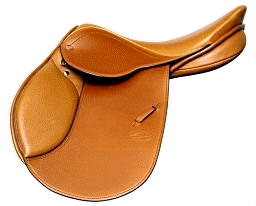 Jumping Jumping
or Close
Contact saddles are designed for hunter/jumper classes. With
its flatter seat and lower cantle, it allows the rider to get
well out of the seat in the
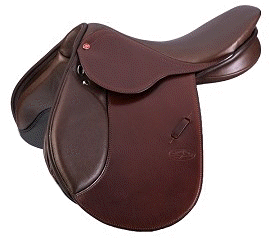 two point position to clear fences.
Stirrup bars are position more forward in order for the rider to
keep his knees in correct position as he raises in the saddle
with shorter stirrups. This rider has more bend in his knee and
more forward position as the mule takes the jumps. The panels
and knee rolls are thin and the rider has very close contact
with the mule. They make this saddle specifically for jumping
and competition. It has a more sloping head to allow for a more
forward cut panel and flap to accommodate a more forward knee
because of shorter stirrups. The jumping saddle is also built
on a narrow twist (the narrowest part of the saddle and
the area in which most of the rider=s
weight is borne). Because of its flat seat and narrow weight
bearing surface, it is not a comfortable saddle for either mule
or rider for trail riding or long periods in the saddle. two point position to clear fences.
Stirrup bars are position more forward in order for the rider to
keep his knees in correct position as he raises in the saddle
with shorter stirrups. This rider has more bend in his knee and
more forward position as the mule takes the jumps. The panels
and knee rolls are thin and the rider has very close contact
with the mule. They make this saddle specifically for jumping
and competition. It has a more sloping head to allow for a more
forward cut panel and flap to accommodate a more forward knee
because of shorter stirrups. The jumping saddle is also built
on a narrow twist (the narrowest part of the saddle and
the area in which most of the rider=s
weight is borne). Because of its flat seat and narrow weight
bearing surface, it is not a comfortable saddle for either mule
or rider for trail riding or long periods in the saddle.
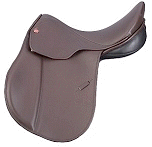 All-Purpose
saddles, often called Event saddles,
are designed with a deeper seat and stirrups farther back for a
longer leg position. The All-Purpose
saddles, often called Event saddles,
are designed with a deeper seat and stirrups farther back for a
longer leg position. The
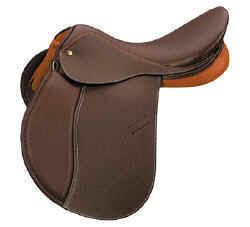 head
has about a 45 degree sloped. The panel is cut wider than
the close contact saddle to allow the rider to use a longer
stirrup leather for work on the flat or to raise the stirrup for
jumping and still have the leg positioned on the flap. The
deeper seat, the wider knee rolls and the often found suede
covering on the flaps add to the security of this saddle.
This saddle is comfortable and meets the needs of trail riding,
cross country and jumping. This saddle is perfectly
suitable for Hunter Under Saddle, Hunter Hack, Working Hunter
and Jumping classes in mule shows. It is also suitable for
the lower levels of dressage. Different types may have a
construction more suitable for dressage than hunt or vice versa.
This is a good choice for your first English saddle. head
has about a 45 degree sloped. The panel is cut wider than
the close contact saddle to allow the rider to use a longer
stirrup leather for work on the flat or to raise the stirrup for
jumping and still have the leg positioned on the flap. The
deeper seat, the wider knee rolls and the often found suede
covering on the flaps add to the security of this saddle.
This saddle is comfortable and meets the needs of trail riding,
cross country and jumping. This saddle is perfectly
suitable for Hunter Under Saddle, Hunter Hack, Working Hunter
and Jumping classes in mule shows. It is also suitable for
the lower levels of dressage. Different types may have a
construction more suitable for dressage than hunt or vice versa.
This is a good choice for your first English saddle.
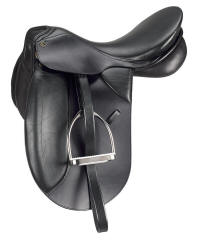 Dressage
saddles are designed with straighter Dressage
saddles are designed with straighter
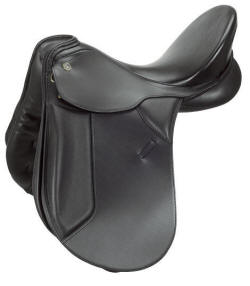 flaps and stirrup bars positioned farther back to obtain the
lengthened and correct leg position. They have a vertical
or only slight sloping head. With a deeper seat than the
close contact, the dressage saddle holds
you securely in one position - the correct
dressage position with the rider more upright on the seat bones.
Stuffing is generally kept to minimum for
closer contact. This saddle is not designed to allow the
rider movement that close contact and all purpose saddles do.
Extra padding under the billet provides better weight
distribution over the mule's
back. The billets on the dressage saddle are considerably
longer than the other saddles to prevent the buckles from
interfering with the rider's
legs. flaps and stirrup bars positioned farther back to obtain the
lengthened and correct leg position. They have a vertical
or only slight sloping head. With a deeper seat than the
close contact, the dressage saddle holds
you securely in one position - the correct
dressage position with the rider more upright on the seat bones.
Stuffing is generally kept to minimum for
closer contact. This saddle is not designed to allow the
rider movement that close contact and all purpose saddles do.
Extra padding under the billet provides better weight
distribution over the mule's
back. The billets on the dressage saddle are considerably
longer than the other saddles to prevent the buckles from
interfering with the rider's
legs.
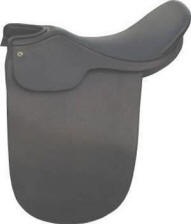 Lane-Fox
or Show Saddle is designed to be used in Saddle Seat
classes in park, pleasure and equitation. Build on an
extreme cut back tree (these are referred to as cut back)
and a
very long, flat seat, this saddle was designed specifically for
show. It allows the Lane-Fox
or Show Saddle is designed to be used in Saddle Seat
classes in park, pleasure and equitation. Build on an
extreme cut back tree (these are referred to as cut back)
and a
very long, flat seat, this saddle was designed specifically for
show. It allows the
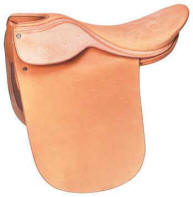 level topline of the mule to be seen and allows the rider to
sit back farther to show off the mule=s
front end. The rider is extremely close to the mule and the
wide flap is designed to keep the rider=s
leg in a position that further complement the mule=s
conformation. Because the mule=s
head and neck level topline of the mule to be seen and allows the rider to
sit back farther to show off the mule=s
front end. The rider is extremely close to the mule and the
wide flap is designed to keep the rider=s
leg in a position that further complement the mule=s
conformation. Because the mule=s
head and neck
are carried, the center of gravity of a gaited
mule is farther back. The cut back saddle allows the rider to
shift his weight farther back on the mule and is set back 2-3
inches to the rear of the all purpose saddle. 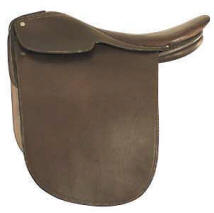 Panels have
minimum padding. Long stirrups permit the riders heels to drop
almost directly below his center of gravity. Panels have
minimum padding. Long stirrups permit the riders heels to drop
almost directly below his center of gravity.
This is a saddle
of maximum contact. There are deeper seat versions for
equitation and will help the rider who is taking lessons stay in
the correct position. This is the saddle that the gaited mules
will be shown in their English classes. Again, this is not a
comfortable saddle for either rider or mule for long hours or
riding.
Saddle Trees
The saddle
tree determines the ultimate shape and design of the saddle. It
assigns the saddle to what discipline for which it will be best
suited, what position the rider will be in and how it fits the
mule. It creates the depth and breadth of the seat.
They are generally made of
laminated beechwood to fiberglass. Regardless of type of the
type of material used, poor construction of the tree will make
the saddle worthless. The tree, its construction and integrity
are the most important factors in choosing any saddle.
English saddles are built either
on a rigid tree or a spring tree. Both generally are reinforced
with steel for strength and durability. You will find steel
plates along the head (front arch of the saddle), the gullet and
the cantle.
The spring tree, however, utilizes two metal
strips running along the widest part of the seat. They extend
from the head of the saddle to the rear of the tree directly
under the rider=s
seat. This allows some give to the saddle and increases the
rider=s
comfort, allows closer and more direct contact through the seat
bones and, very importantly, is more comfortable for the mule.
Spring trees tend to be deep seats placing the rider in an
upright position.
A rigid tree does not allow this
movement. It is constructed with either a straight head for
normal use or with a cut back head for use in saddle seat
saddles. They are also used for wider back breeds such as
Arabians, Morgans and some mules with similar conformation.
Rigid trees are the base for flatter seats, but they tend to
allow the rider to easily fall out of balance.
Most mules
and horses require a standard tree. However, some breeds may
require a wide tree. Of course, just like the western saddles,
you can get the tree custom made to your mule and then have the
saddle built to suit your riding discipline and comfort.
However, if that is not in your plans or budget, at least take
your mule to the tack shop and try on the various saddles and
trees available. Mules are as individual to fit as horses.
Riders require different sizes
based on the tree length. The average size adult woman rider
usually requires a 17-inch saddle. To determine if a hunt seat
saddle fits you, sit in the deepest part of the saddle where you
would normally ride. If you can reach behind you and place your
hand palm down and have just enough room to fit your hand
between your seat and the end of the cantle, it fits.
Padding
Both the
spring and rigid trees are fitted with webbing and padded.
Panels come in two varieties - stuffed and formed. Stuffed
panels are generally found in American and European saddles.
Many English made saddles, however, may come with formed
panels. Formed panels will not change shape over time and
wear. They either fit the horse or don't
. Consequently, it might be wise to choose a hand stuffed panel
for hard to fit mules. However, keep in mind that stuffed
panels have problems of their own.
In the hand stuffed panels felt,
foam rubber, wool or leather are materials used for padding
which can then be enclosed in leather or serge. This hand
stuffing requires great accuracy. Whether natural or synthetic
materials are used, the panels should be stuffed so that the
weight bearing is evenly flocked and level on both sides of the
channel.
A lumpy, uneven stuffing can
cause pressure points and sore the mule=s
back. It can throw the tree and rider out of balance. Too much
padding can restrict the contact with the back and too little
can cause bruising of the mule=s
back.
Since these panels are stuffed by
hand, there could be a discrepancy in the balance and symmetry
of these panels as compared with the formed. In addition,
although the stuffing may mold exactly to your mule=s
back, over time and wear the stuffing material can be come
uneven and lumpy. If this happens, they can be re
stuffed.
The stuffing is enclosed in leather
and it is recommended that pigskin be kept for the softer areas of
the seat of the saddle. Pigskin is not a particularly strong leather
and, while soft and supple, would not be used in this area that you
would want to be long wearing.
Saddle Seat
Various types of
leather can be used for the saddle seat from pigskin to doeskin to
calfskin. Suede is also used for its sticking power, but can smooth
out after use over several years. The leather used for the seat is
an individual preference for the rider.
Stirrup Bars
Bars are made
from either forged or cast steel. They are usually stamped either
Aforged@
or
Acast@
according to the method of manufacture. The forged are the
strongest and the safest of two types.
Most of them still have the archaic
Asafety
catch@
at the end. These catches were used on older saddles to keep the
stirrup leather from slipping off the bar. Today, however, the
saddle construction has improved so much that rarely happens in the
better made saddles. Consequently, it is recommended NOT to engage
this catch as it can be more dangerous than not in the
Asafety@
position.
Some of the newer saddles have what
is called an
Aadjustable@
bar which allows the movement of the stirrup bar to accommodate
different desired leg positions. Since leg position is so critical
in dressage, many of these saddles have this feature. One of the
best, less cumbersome adjustable bar is the Wellep, a simple device
which allows five positions of the stirrup.
Fittings
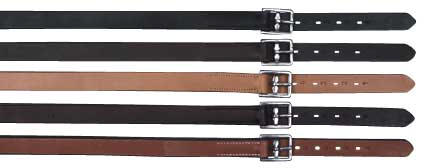 The fittings are
usually not included in the purchase of an English saddle. They are
sold
Aless
fittings@.
They are extra and subject to the whims, likes and dislikes of the
riders. The fittings are
usually not included in the purchase of an English saddle. They are
sold
Aless
fittings@.
They are extra and subject to the whims, likes and dislikes of the
riders.
Never underestimate the need for
quality stirrup leathers. Don=t
make the mistake investing a substantial amount in the saddle and
then fail to pay as close attention to the quality of your stirrup
leathers.
Stirrup leathers need to be
substantial, good quality leather. They generally come in three
types of leather - oxhide, rawhide or buffalo hide. They are also
made in synthetic materials today like nylon webbing, plastic and
others. Real leathers come with a smooth side and rough side. In
oxhide and rawhide, the flesh side (rough side) is made to face
outwards so the grain side receives the friction from the stirrup
bar and the stirrup itself. With the buffalo hide, the reverse is
true.
It is important to make sure the
stitching around the buckle is heavy and triple and that the buckle
is stainless. They range from 7/8 to 1 1/8 inches wide. Usually
the standard 54" leathers will be appropriate for most riders.
All leathers will stretch with time
and most riders have the habit of putting more weight in one stirrup
than the other causing one stirrup leather to stretch more than the
other. So it is a good idea to switch leathers periodically to
compensate.
Quality leathers have evenly punched
holes and will be numbered for your convenience in getting them even
on each side.
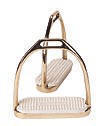 Stirrup
irons should be made of stainless steel.
Anything else is a waste of money. English stirrups come in
two types - regular and offset. The regular style has the eye
center so that when resting on a flat surface, the stirrup lies
perfectly symmetrical. This is the most
popular and comes in a variety of weights, shapes and sizes. Stirrup
irons should be made of stainless steel.
Anything else is a waste of money. English stirrups come in
two types - regular and offset. The regular style has the eye
center so that when resting on a flat surface, the stirrup lies
perfectly symmetrical. This is the most
popular and comes in a variety of weights, shapes and sizes.
The offset style has the eye offset
so that it leans more in one direction than the other. These offset
irons are keyed to right or left since it is the tile that
encourages the rider to keep the ankles cocked, heels down and
weight on the inside ball of the foot. The offset is acceptable in
Huntseat, but not in dressage.
When choosing your irons, make sure
the eye width will accommodate the width of leather you have
chosen.
 Stirrup pads
also come in a variety of materials for better grip. They range
from rough textured Stirrup pads
also come in a variety of materials for better grip. They range
from rough textured
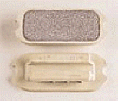 metal to sand paper type finishes on rubber.
The rubber pads are most popular now and actually keep the toes
warmer in colder weather. metal to sand paper type finishes on rubber.
The rubber pads are most popular now and actually keep the toes
warmer in colder weather.
In choosing irons keep in mind the
weight of the iron. The heavier the iron, the easier it is to find
and recover if lost. Also keep in mind that too narrow a stirrup
can cause the boot to hang up and too wide a stirrup makes it easy
to loose.
Girths
range from leather to cotton to synthetics, some
fitted with foam centers. Again,
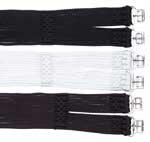 preference
is a matter of choice and may change from one discipline to another
to one mule to another. Important in
choosing a girth, is the comfort of the mule. The girth
should be absorbent, soft and formed to reduce the possibility of
chaffing. It should be broad enough,
however, to distribute pressure and not bind. preference
is a matter of choice and may change from one discipline to another
to one mule to another. Important in
choosing a girth, is the comfort of the mule. The girth
should be absorbent, soft and formed to reduce the possibility of
chaffing. It should be broad enough,
however, to distribute pressure and not bind.
For some mules who are straighter
shoulders, larger bellied with high croups, galling problems occur.
For these types of conformation, make an effort to find the narrower
Balding and Atherstone pattern girths. In addition, buckle
protectors can be purchased.
 
|



 Jumping
Jumping
 two point position to clear fences.
Stirrup bars are position more forward in order for the rider to
keep his knees in correct position as he raises in the saddle
with shorter stirrups. This rider has more bend in his knee and
more forward position as the mule takes the jumps. The panels
and knee rolls are thin and the rider has very close contact
with the mule. They make this saddle specifically for jumping
and competition. It has a more sloping head to allow for a more
forward cut panel and flap to accommodate a more forward knee
because of shorter stirrups. The jumping saddle is also built
on a narrow twist (the narrowest part of the saddle and
the area in which most of the rider
two point position to clear fences.
Stirrup bars are position more forward in order for the rider to
keep his knees in correct position as he raises in the saddle
with shorter stirrups. This rider has more bend in his knee and
more forward position as the mule takes the jumps. The panels
and knee rolls are thin and the rider has very close contact
with the mule. They make this saddle specifically for jumping
and competition. It has a more sloping head to allow for a more
forward cut panel and flap to accommodate a more forward knee
because of shorter stirrups. The jumping saddle is also built
on a narrow twist (the narrowest part of the saddle and
the area in which most of the rider All-Purpose
saddles, often called Event saddles,
are designed with a deeper seat and stirrups farther back for a
longer leg position. The
All-Purpose
saddles, often called Event saddles,
are designed with a deeper seat and stirrups farther back for a
longer leg position. The
 head
has about a 45 degree sloped. The panel is cut wider than
the close contact saddle to allow the rider to use a longer
stirrup leather for work on the flat or to raise the stirrup for
jumping and still have the leg positioned on the flap. The
deeper seat, the wider knee rolls and the often found suede
covering on the flaps add to the security of this saddle.
This saddle is comfortable and meets the needs of trail riding,
cross country and jumping. This saddle is perfectly
suitable for Hunter Under Saddle, Hunter Hack, Working Hunter
and Jumping classes in mule shows. It is also suitable for
the lower levels of dressage. Different types may have a
construction more suitable for dressage than hunt or vice versa.
This is a good choice for your first English saddle.
head
has about a 45 degree sloped. The panel is cut wider than
the close contact saddle to allow the rider to use a longer
stirrup leather for work on the flat or to raise the stirrup for
jumping and still have the leg positioned on the flap. The
deeper seat, the wider knee rolls and the often found suede
covering on the flaps add to the security of this saddle.
This saddle is comfortable and meets the needs of trail riding,
cross country and jumping. This saddle is perfectly
suitable for Hunter Under Saddle, Hunter Hack, Working Hunter
and Jumping classes in mule shows. It is also suitable for
the lower levels of dressage. Different types may have a
construction more suitable for dressage than hunt or vice versa.
This is a good choice for your first English saddle. Dressage
saddles are designed with straighter
Dressage
saddles are designed with straighter
 flaps and stirrup bars positioned farther back to obtain the
lengthened and correct leg position. They have a vertical
or only slight sloping head. With a deeper seat than the
close contact, the dressage saddle holds
you securely in one position - the correct
dressage position with the rider more upright on the seat bones.
Stuffing is generally kept to minimum for
closer contact. This saddle is not designed to allow the
rider movement that close contact and all purpose saddles do.
Extra padding under the billet provides better weight
distribution over the mule's
back. The billets on the dressage saddle are considerably
longer than the other saddles to prevent the buckles from
interfering with the rider's
legs.
flaps and stirrup bars positioned farther back to obtain the
lengthened and correct leg position. They have a vertical
or only slight sloping head. With a deeper seat than the
close contact, the dressage saddle holds
you securely in one position - the correct
dressage position with the rider more upright on the seat bones.
Stuffing is generally kept to minimum for
closer contact. This saddle is not designed to allow the
rider movement that close contact and all purpose saddles do.
Extra padding under the billet provides better weight
distribution over the mule's
back. The billets on the dressage saddle are considerably
longer than the other saddles to prevent the buckles from
interfering with the rider's
legs. Lane-Fox
or Show Saddle is designed to be used in Saddle Seat
classes in park, pleasure and equitation. Build on an
extreme cut back tree (these are referred to as cut back)
and a
very long, flat seat, this saddle was designed specifically for
show. It allows the
Lane-Fox
or Show Saddle is designed to be used in Saddle Seat
classes in park, pleasure and equitation. Build on an
extreme cut back tree (these are referred to as cut back)
and a
very long, flat seat, this saddle was designed specifically for
show. It allows the
 level topline of the mule to be seen and allows the rider to
sit back farther to show off the mule
level topline of the mule to be seen and allows the rider to
sit back farther to show off the mule Panels have
minimum padding. Long stirrups permit the riders heels to drop
almost directly below his center of gravity.
Panels have
minimum padding. Long stirrups permit the riders heels to drop
almost directly below his center of gravity.  The fittings are
usually not included in the purchase of an English saddle. They are
sold
The fittings are
usually not included in the purchase of an English saddle. They are
sold
 Stirrup
irons should be made of stainless steel.
Anything else is a waste of money. English stirrups come in
two types - regular and offset. The regular style has the eye
center so that when resting on a flat surface, the stirrup lies
perfectly symmetrical. This is the most
popular and comes in a variety of weights, shapes and sizes.
Stirrup
irons should be made of stainless steel.
Anything else is a waste of money. English stirrups come in
two types - regular and offset. The regular style has the eye
center so that when resting on a flat surface, the stirrup lies
perfectly symmetrical. This is the most
popular and comes in a variety of weights, shapes and sizes. Stirrup pads
also come in a variety of materials for better grip. They range
from rough textured
Stirrup pads
also come in a variety of materials for better grip. They range
from rough textured
 metal to sand paper type finishes on rubber.
The rubber pads are most popular now and actually keep the toes
warmer in colder weather.
metal to sand paper type finishes on rubber.
The rubber pads are most popular now and actually keep the toes
warmer in colder weather.  preference
is a matter of choice and may change from one discipline to another
to one mule to another. Important in
choosing a girth, is the comfort of the mule. The girth
should be absorbent, soft and formed to reduce the possibility of
chaffing. It should be broad enough,
however, to distribute pressure and not bind.
preference
is a matter of choice and may change from one discipline to another
to one mule to another. Important in
choosing a girth, is the comfort of the mule. The girth
should be absorbent, soft and formed to reduce the possibility of
chaffing. It should be broad enough,
however, to distribute pressure and not bind. 
